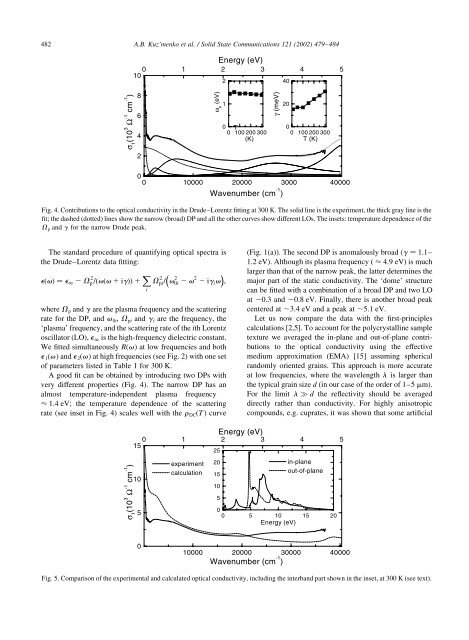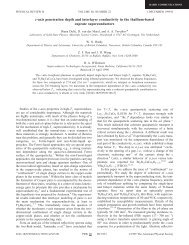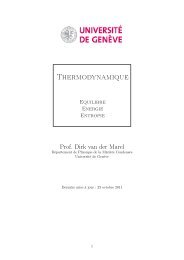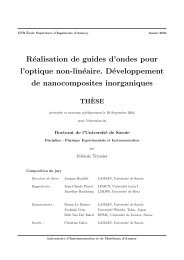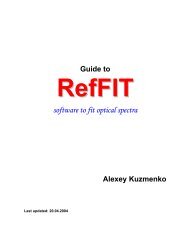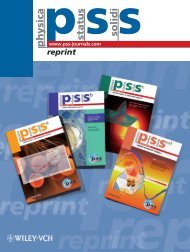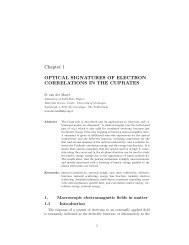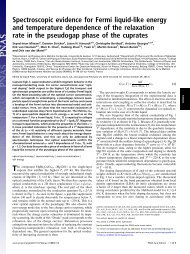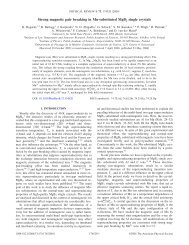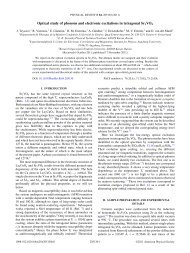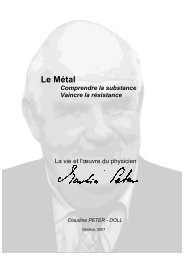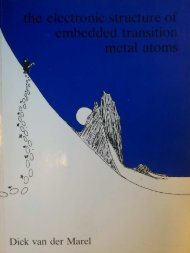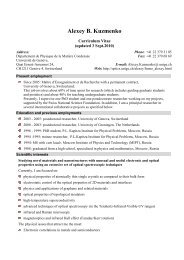Manifestation of multiband optical properties of MgB2
Manifestation of multiband optical properties of MgB2
Manifestation of multiband optical properties of MgB2
You also want an ePaper? Increase the reach of your titles
YUMPU automatically turns print PDFs into web optimized ePapers that Google loves.
482<br />
σ 1 (10 3 Ω -1 cm -1 )<br />
The standard procedure <strong>of</strong> quantifying <strong>optical</strong> spectra is<br />
the Drude±Lorentz data ®tting:<br />
e…v† ˆe 1 2 V 2 p =…v…v 1 ig†† 1 X<br />
i<br />
V 2 pi= v 2 0i 2 v 2 2 ig iv ;<br />
where V p and g are the plasma frequency and the scattering<br />
rate for the DP, and v 0i, V pi and g i are the frequency, the<br />
`plasma' frequency, and the scattering rate <strong>of</strong> the ith Lorentz<br />
oscillator (LO), e 1 is the high-frequency dielectric constant.<br />
We ®tted simultaneously R(v) at low frequencies and both<br />
e 1(v) and e 2(v) at high frequencies (see Fig. 2) with one set<br />
<strong>of</strong> parameters listed in Table 1 for 300 K.<br />
A good ®t can be obtained by introducing two DPs with<br />
very different <strong>properties</strong> (Fig. 4). The narrow DP has an<br />
almost temperature-independent plasma frequency<br />
< 1.4 eV; the temperature dependence <strong>of</strong> the scattering<br />
rate (see inset in Fig. 4) scales well with the r DC(T ) curve<br />
A.B. Kuz'menko et al. / Solid State Communications 121 (2002) 479±484<br />
10<br />
8<br />
6<br />
4<br />
2<br />
Energy (eV)<br />
0 1 2 3 4 5<br />
ω p (eV)<br />
2<br />
1<br />
0 T<br />
0 100 200 300<br />
(K)<br />
0<br />
0 100 200 300<br />
T(K)<br />
0<br />
0 10000 20000 3000 40000<br />
Wavenumber (cm -1 )<br />
Fig. 4. Contributions to the <strong>optical</strong> conductivity in the Drude±Lorentz ®tting at 300 K. The solid line is the experiment, the thick gray line is the<br />
®t; the dashed (dotted) lines show the narrow (broad) DP and all the other curves show different LOs. The insets: temperature dependence <strong>of</strong> the<br />
V p and g for the narrow Drude peak.<br />
σ 1 (10 3 Ω -1 cm -1 )<br />
15<br />
10<br />
5<br />
0<br />
experiment<br />
calculation<br />
γ (meV)<br />
40<br />
20<br />
(Fig. 1(a)). The second DP is anomalously broad (g < 1.1±<br />
1.2 eV). Although its plasma frequency ( < 4.9 eV) is much<br />
larger than that <strong>of</strong> the narrow peak, the latter determines the<br />
major part <strong>of</strong> the static conductivity. The `dome' structure<br />
can be ®tted with a combination <strong>of</strong> a broad DP and two LO<br />
at ,0.3 and ,0.8 eV. Finally, there is another broad peak<br />
centered at ,3.4 eV and a peak at ,5.1 eV.<br />
Let us now compare the data with the ®rst-principles<br />
calculations [2,5]. To account for the polycrystalline sample<br />
texture we averaged the in-plane and out-<strong>of</strong>-plane contributions<br />
to the <strong>optical</strong> conductivity using the effective<br />
medium approximation (EMA) [15] assuming spherical<br />
randomly oriented grains. This approach is more accurate<br />
at low frequencies, where the wavelength l is larger than<br />
the typical grain size d (in our case <strong>of</strong> the order <strong>of</strong> 1±5 mm).<br />
For the limit l q d the re¯ectivity should be averaged<br />
directly rather than conductivity. For highly anisotropic<br />
compounds, e.g. cuprates, it was shown that some arti®cial<br />
Energy (eV)<br />
0 1 2 3 4 5<br />
25<br />
20<br />
15<br />
10<br />
5<br />
in-plane<br />
out-<strong>of</strong>-plane<br />
0<br />
0 5 10<br />
Energy (eV)<br />
15 20<br />
10000 20000 30000 40000<br />
Wavenumber (cm -1 )<br />
Fig. 5. Comparison <strong>of</strong> the experimental and calculated <strong>optical</strong> conductivity, including the interband part shown in the inset, at 300 K (see text).


